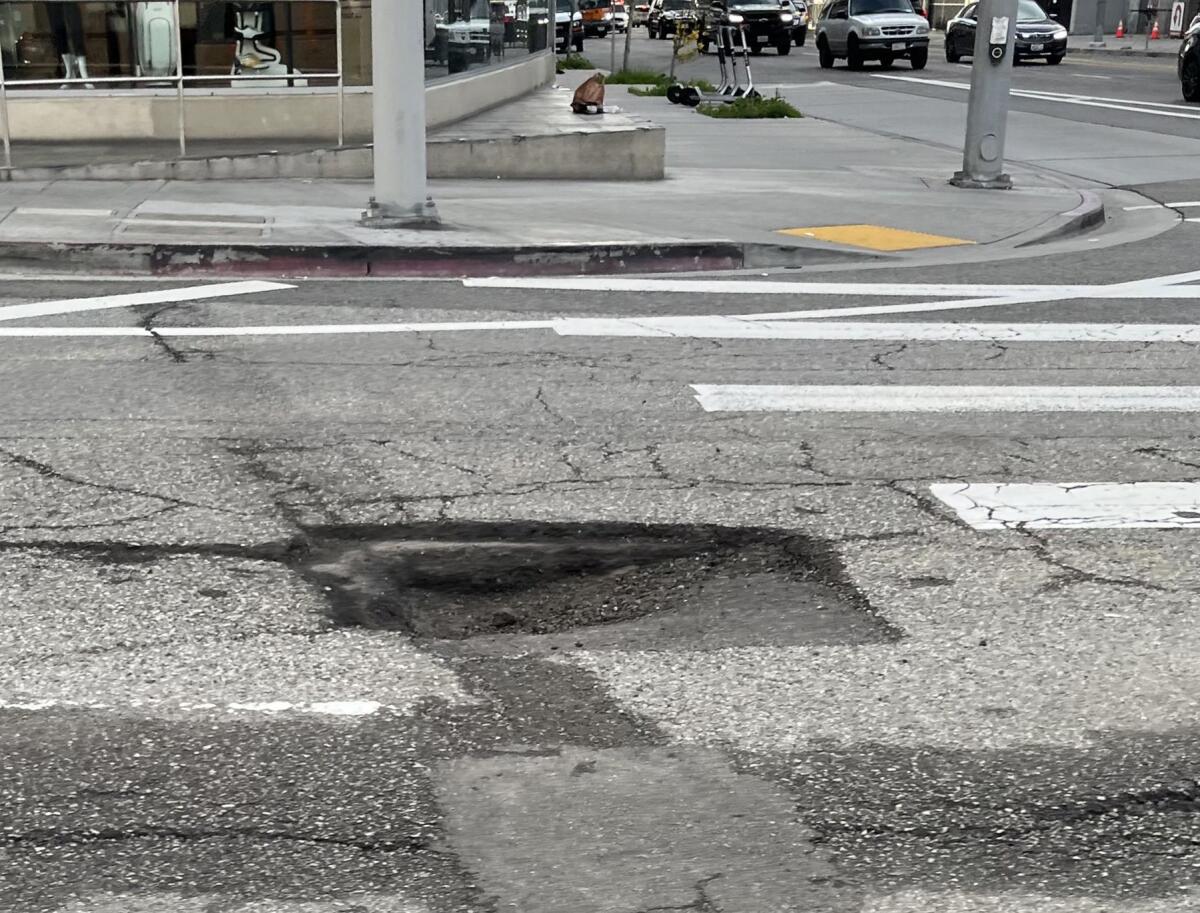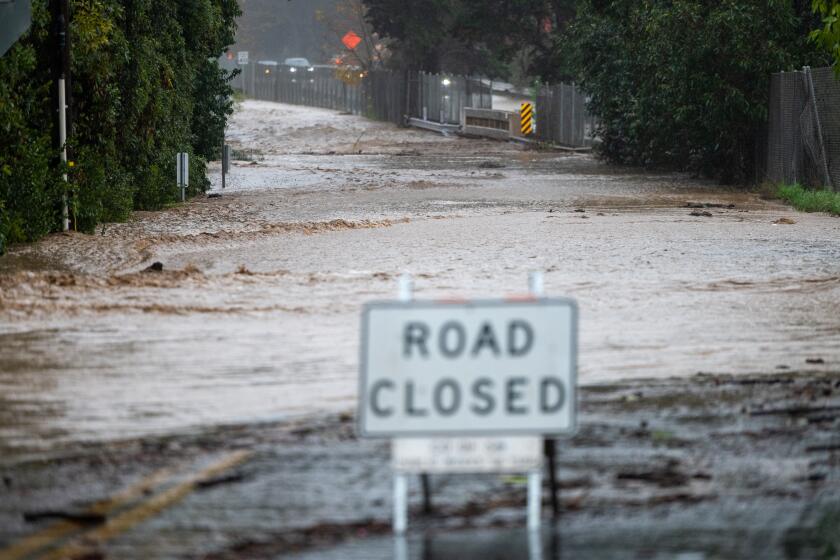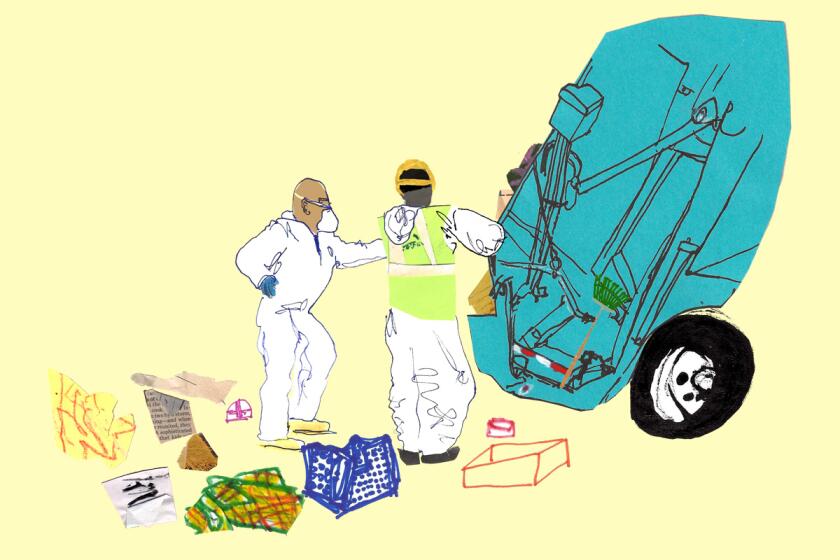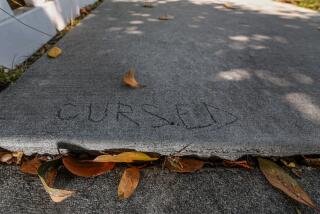More rain means more car-damaging potholes. Here’s how to get repaid

There are more than 7,500 miles of streets in the city of Los Angeles.
Just imagine how many potholes they’ll have after a few more days of heavy rain.
Driving over a pothole can damage a tire, wheel rim or axle; if the impact is severe enough, it can affect the vehicle’s suspension, undercarriage, body or even its frame. According to a new survey by the American Automobile Assn., an estimated 44 million U.S. drivers suffered pothole damage last year, with an average of $406 spent on repairs. Tires were the most frequent victims, followed by vehicle alignment and wheels, AAA found.
If your ride has been sabotaged by a pothole hidden under a pool of water or rendered invisible by an unlit street, you have ways to seek reimbursement for the damage.
Here are the steps you can take.
Road closures and treacherous driving conditions have confronted drivers as agencies work to repair potholes caused by the winter storms.
Take the pothole threat seriously
We all liked to splash through puddles as kids, but our cars are not blessed with supple joints. Plowing through a pothole can be really bad for your vehicle. So the first line of defense is to not hit any. That means staying well behind the car in front of you, enabling you to see the surface of the road ahead and react in time to avoid craters.
It also means keeping your tires inflated properly. Underinflated tires don’t have as much air in them to absorb the pounding, so more of the damaging impact gets passed on to your suspension. Overinflated tires, meanwhile, offer too little cushioning.
You may think you know the location of every pothole on the roads you drive frequently, but the rain has a way of creating new ones. Water seeps into cracks in the pavement, weakening the layers beneath the surface. As vehicles hit these spots again and again — the rain tends to bring out more cars, not fewer — the weakened areas become ever-larger holes.
That’s why it’s hard to avoid hitting potholes, even on routes you know well. When you find yourself about to hit one, take your foot off the gas and stay off the brakes, experts advise. That’s because hitting the brakes tends to compress the suspension and lower the nose of your vehicle, giving the suspension less room to absorb the blow.
Don’t swerve, either, the TiresPlus auto parts chain advises.
“Swerving into the pothole at an angle can cause your front tire to hit the edge sharply. This can cause greater damage than driving straight over the pothole,” TiresPlus says on its website. “Even more importantly, swerving violently can mean leaving your lane of traffic or leaving the roadway — two scenarios that can have much worse outcomes than simply hitting a pothole.”
Make sure to fix small pothole-related problems right away.
“Look for changes in vehicle handling, excessive vibration or uneven wearing of tires, all indications of a problem with the suspension like alignment or shocks,” AAA advises. “If your vehicle pulls to the left or right, have the wheel alignment checked by a trusted mechanic.”
And if you see a pothole, report it. The Times’ Shape Your L.A. app can show you how to report a pothole that needs repairing (or any number of other everyday concerns) to your city government — so you and everyone else can drive a little less anxiously.
Headlights on. Foot off the gas pedal. And if you see a flooded street, turn around. Here are tips for driving safely as California gets drenched.
File an auto insurance claim
This option is available only if you pay for collision coverage, which is not mandatory. According to the Insurance Information Institute, this covers “damage to a car resulting from a collision with an object (e.g., a pothole, lamp post or guard rail), another car or as the result of flipping over. However, it does not cover wear and tear to a car or its tires due to bad road conditions.”
There are at least two reasons not to file a claim, however. First, you may have set your deductible at a relatively high level, such as $500 or $1,000, to keep your premiums down. If the cost of your repairs is less than or equal to your deductible, your insurance won’t pay a thing.
Second, if your claim is large enough to generate a payment, your insurer will probably try to recoup its cost over time through higher premiums.
“Since hitting a pothole is considered a single-vehicle accident, your insurer will usually deem you at fault for the incident unless there’s evidence that another vehicle caused you to hit the pothole,” Progressive Insurance says on its website. “Although your insurance provider will cover the damage if you have collision coverage, you may see an increase in your insurance rates at renewal time.”
Is there abandoned furniture on your block? Pothole driving you nuts on your commute? Use Shape Your L.A. to learn how to get your city government to address everyday issues.
File a claim against the government
State law holds the government responsible for dangerous conditions on public property, but only if the government knew or should have known about them. So if you file a claim against a city, county or the state, you need to be prepared for a tussle to get reimbursed.
Any claim must be filed within six months of the damage occurring.
Attorney Allen Patatanyan, managing partner of West Coast Trial Lawyers, said you’ll need to prove a few things to establish the government’s liability. But showing that the government was or should have been on notice about the pothole before your accident “is a big, big issue,” he said.
The law provides two ways to do this. One is to demonstrate that the government had been told about the pothole or had spotted it during an inspection, Patatanyan said. The other tactic, called “constructive notice,” is to establish that the government would have learned about the pothole if it had a reasonable inspection routine.
Finding out whether the government knew about a pothole typically requires a public records request to pull all complaints received about that particular roadway, along with accident reports and inspection records. Los Angeles gets a lot of complaints — the Department of Public Works said it received 5,869 requests for pothole repairs in the first three weeks of March alone. The department said its crews had fixed almost 4,000 of them, leaving about 30% unfilled at that point. And that’s just for the latest complaints.
Unless you can point to complaints, accidents or inspection records that put the government on notice about a pothole, you’re left to prove that the government should have known about it. That’s the kind of thing you’d use an expert witness to argue in court, Patatanyan said.
The circumstances matter, too. For example, you might argue that after heavy rain, the government should have stepped up inspections of roads with aging pavement.
Potholes as big as 4 feet across force CHP to shut down a short stretch of the northbound 71 Freeway in Pomona after dozens of cars were damaged.
At any rate, the first step in filing a claim is figuring out which government entity is responsible for maintaining the road you were on when you slammed into that pothole.
- Los Angeles and other big cities are answerable for potholes on the streets (but not highways) within their boundaries. Here’s a link to L.A.’s claim form.
- Counties are responsible for streets in unincorporated areas and in smaller cities that pay the county to maintain them. Here’s a link to L.A. County’s claim form.
- Caltrans, the state transportation department, is on the hook for potholes on federal and state highways.
For Caltrans claims of $10,000 or less, download a form, then send the completed version to the Caltrans District Claims Office serving the county where the pothole is located. For Los Angeles and Ventura counties, that office is on the 13th floor at 100 South Main St. in L.A. For claims of more than $10,000, Caltrans instructs you to request a form by writing to: Government Claims Program, Office of Risk and Insurance Management, Department of General Services, P.O. Box 989052, MS 414, West Sacramento, CA 95798-9052.
The forms ask for names of witnesses and invite you to submit evidence supporting your claim, such as repair bills. Although they don’t specifically ask you to prove that the government knew or should have known about the pothole, each form has a section asking you to explain why you think the government is responsible.
For example, the city of Los Angeles’ form asks, “What particular ACT or OMISSION do you claim caused the injury or damage?” The state form asks, “What do you claim Caltrans or its contractor did to cause your injury or damage?”
Progressive Insurance cautions that it can take a long time to prevail in a claim against the government, “so if your vehicle isn’t drivable, it may make more sense to file an insurance claim for the pothole damage or pay for the repairs out of pocket and then file for reimbursement from the city later.” Bear in mind, though, that any claim must be filed within six months of the pothole strike.
The larger your claim, the more likely the government will be to deny it, at which point you’ll have to seek reimbursement in court. In particular, Patatanyan said, if you’re making a claim where injuries are involved, “that’s when the fight begins.”
The Los Angeles City Council voted Friday to spend $6.1 million to settle a lawsuit filed by a motorcyclist who suffered a severe brain injury when he crashed after hitting several potholes on a San Pedro street in 2015.
About The Times Utility Journalism Team
This article is from The Times’ Utility Journalism Team. Our mission is to be essential to the lives of Southern Californians by publishing information that solves problems, answers questions and helps with decision making. We serve audiences in and around Los Angeles — including current Times subscribers and diverse communities that haven’t historically had their needs met by our coverage.
How can we be useful to you and your community? Email utility (at) latimes.com or one of our journalists: Jon Healey, Ada Tseng, Jessica Roy and Karen Garcia.
More to Read
Sign up for Essential California
The most important California stories and recommendations in your inbox every morning.
You may occasionally receive promotional content from the Los Angeles Times.














